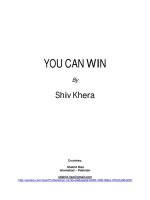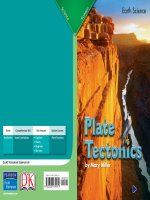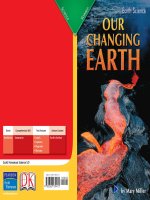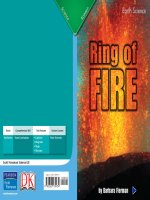3 9 you can recycle (earth science)
Bạn đang xem bản rút gọn của tài liệu. Xem và tải ngay bản đầy đủ của tài liệu tại đây (2.79 MB, 10 trang )
Genre
Nonfiction
Comprehension Skill
Compare and
Contrast
Text Features
•
•
•
•
Captions
Diagrams
Labels
Glossary
Science Content
Natural Resources
Scott Foresman Science 3.9
ISBN 0-328-13834-7
ì<(sk$m)=bdidea< +^-Ä-U-Ä-U
Vocabulary
Extended Vocabulary
conservation
natural resource
nonrenewable resource
recycle
renewable resource
compost
cullet
discarded
landfill
ore
pulp
toxin
Picture Credits
Every effort has been made to secure permission and provide appropriate credit for photographic material.
The publisher deeply regrets any omission and pledges to correct errors called to its attention in subsequent editions.
Photo locators denoted as follows: Top (T), Center (C), Bottom (B), Left (L), Right (R), Background (Bkgd).
3 (TL) Brand X Pictures, (TR) ©Comstock Inc.; 4 Greenshoots Communications/Alamy Images;
6 Joseph Sohm/ChromoSohm Inc./Corbis; 7 Chad Ehlers/Alamy Images; 8 (L) Getty Images, (BC) Jean Heguy/Corbis;
9 (TR) Peter Frischmuth/Peter Arnold, Inc.; 10 Arthur Tilley/Getty Images; 11 Lorenzo Lees/Ecoscene;
15 Erika Stone/Photo Researchers, Inc.
Unless otherwise acknowledged, all photographs are the copyright © of Dorling Kindersley, a division of Pearson.
ISBN: 0-328-13834-7
Copyright © Pearson Education, Inc. All Rights Reserved. Printed in the United States of America.
This publication is protected by Copyright, and permission should be obtained from the publisher prior to any
prohibited reproduction, storage in a retrieval system, or transmission in any form by any means, electronic,
mechanical, photocopying, recording, or likewise. For information regarding permission(s), write to
Permissions Department, Scott Foresman, 1900 East Lake Avenue, Glenview, Illinois 60025.
3 4 5 6 7 8 9 10 V010 13 12 11 10 09 08 07 06 05
What did you learn?
1. What portion of the United States’
trash is thrown into landfills? What
portion of our trash is recycled?
2. Explain how plastic gets recycled.
by Patricia Walsh
3. What is cullet? How is it used?
4.
You have read
about recycling and how it affects
landfills. Write to explain how
recycling affects the conservation
of natural resources. Use
information from this book to
support your answer.
5.
Compare and Contrast How are
aluminum and paper alike in the
ways they are recycled? How are
they recycled differently?
What You Already Know
Everything we need and use comes from Earth.
Each of these things is called a natural resource.
Some natural resources, called renewable
resources, can be replaced during our lifetimes.
For instance, trees are a renewable resource. While
you are alive, a young tree will grow into an adult
tree, replacing another tree that has been used.
Some of our natural resources, called
nonrenewable resources, cannot be replaced
during our lifetimes. Oil and coal, which are
found beneath the Earth’s surface, are nonrenewable
resources. The oil we use cannot be replaced
during our lifetimes.
A few resources are never used up. They are
sunlight, wind, and water.
wind farm
items ready for recycling
We need to be careful not to waste or use up
our natural resources. We also need to be careful
not to damage or spoil our air and water. Using
our natural resources wisely is called conservation.
When we reuse and recycle our natural resources,
we are also helping to conserve another natural
resource, our land. When we find a way to keep
our trash from filling up landfills, we are helping
to conserve land.
Natural resources are important to all living
things. How we use and reuse our natural
resources affects our life on Earth. Read on
to find out how to recycle in a way that will
help our planet!
2
3
Facts About Trash
The average American creates about four pounds
of trash each day. Our country produces 210 million
tons of trash each year. Where does it go?
More than half of our trash is buried in landfills.
A landfill is a large area where trash is discarded.
This trash spreads out and piles high, taking up a
lot of space. It is expensive for cities to haul trash
to landfills. Landfills also fill up quickly because
the trash in them does not
decompose well.
Landfills take up a large
amount of space and
are costly to run.
Here’s the good news: Americans
are recycling and composting
more than 25 percent of
their trash! Metal, glass,
and plastic can all be
recycled. When we recycle
Everything here
them, they get changed
can be recycled.
into things we can use again.
Composting is similar to recycling. Natural
yard and kitchen waste gets composted, meaning
it gets returned to the soil.
On the following pages you’ll read about
materials that can be recycled. You’ll also learn
about the energy saved by recycling and
how recycling makes the
environment cleaner!
It’s important to learn
which recyclable
items go in which
recycling bins.
4
5
Aluminum
These aluminum cans
are being sent into
a recycling plant.
6
About 100 billion aluminum
cans are made in the United
States each year. Of that
number, about half are recycled.
For every aluminum can that
gets recycled, one less can has
to be made from new materials.
Natural resources are
conserved when aluminum is
recycled. It takes four pounds
of bauxite ore to make one
pound of aluminum. Less ore
needs to be mined from the
Earth when more aluminum
is recycled.
When you drop an
aluminum can into a recycling
bin, you have helped recycle
aluminum! Scrap metal
companies collect the cans and
crush them into large bales.
The bales are then shredded
into small pieces and melted.
How Aluminum Can Be Recycled
made into
cans and
filled
put out
for recycling
crushed
rolled into
sheets
melted and cast
After that, the recycled
aluminum is blended with
new aluminum and poured
into huge bars. Rolling
mills press the bars into
thin sheets. Finally, the
sheets are formed into
new cans.
By recycling aluminum
cans, you stop them from
becoming trash and taking
up space in a landfill.
New aluminum cans
are made from poured,
melted metal.
7
Paper
The average U.S. resident uses
749 pounds of paper each year.
Books, magazines, newspapers,
and many other things are made of
paper. Thanks to recycling programs,
Americans now recycle more paper
than they throw away.
When you separate paper from
other trash, you have helped recycle
paper! That paper is then sent to
recycling centers. The centers sort it
and remove plastic and paper clips.
Tons and tons of paper get recycled
each year in the United States.
8
After the paper has
been sorted, it is formed
into thousand-pound
bundles and sent to
mills. At the mills, the
recycled paper is soaked
in water and chemicals.
This causes the paper to
This worker is inspecting a
separate into fibers, or
new roll of recycled paper.
pulp. The pulp is then
filtered through screens.
At the same time, the ink from newspapers and
magazines is removed. The clean, recycled pulp
is then mixed with new wood pulp to make new
paper products.
Unlike aluminum, paper cannot be recycled
again and again. After repeated recycling, paper
fibers get so small that they slip through the
screens. At that point, the fibers become waste
and have to be composted, burned, or taken
to a landfill.
These newspapers have
been recycled so many
times they are waste.
9
Plastic
Glass
Many things you use are made of plastic.
Fortunately, much of that plastic can be recycled!
When you drop things made of plastic into
the recycling bin, you have helped recycle plastic!
Collectors then wash and chop the plastic into
flakes. The flakes are then dried and melted.
Then the melted plastic is forced through a screen
to remove toxins and form new plastic strands.
The strands are cooled and chopped into pellets.
Plastic pellets are used to make items such as
flowerpots and carpets.
Many people throw away glass bottles and
jars. It’s too bad, because glass can be recycled
to make new glass!
When you place glass into bins, you have
helped recycle it! Collectors go around picking
up that glass. The glass is separated by color.
The color in brown and green glass cannot be
removed. So recycled glass that is colored can
only make more colored glass.
The glass is broken into small pieces called
cullet. After that, the cullet is crushed, sorted,
cleaned, and mixed with other
raw materials to make
new glass. Recycled
glass can be made
into new jars and
bottles. Best of all,
glass can be recycled
again and again!
It’s important to
learn the basics of
plastic recycling.
Glass recycling bins like
these teach people to
sort glass materials.
10
11
Organic Waste
How Organic Waste Can Be Recycled
Many people have turned
to composting as a way to
recycle organic yard waste.
Organic yard waste includes
grass clippings and leaves that
might otherwise be thrown
Organic materials
into a landfill. Organic kitchen include fruits and
vegetables.
waste can be composted too.
This includes coffee grounds,
eggshells, potato peels, and apple cores. Compost
made of organic yard waste and kitchen waste will
produce a rich soil that can be used in any garden!
Worms help the composting of food and yard
wastes. The worms process the food waste and
yard waste through their bodies. The compost
that comes out makes great soil.
These three photos
show how a red
pepper naturally turns
into compost after
only fifteen days.
12
day 1
day 8
day 15
Plants are
picked and
eaten.
Plants grow
in “new” soil.
It is expensive for cities
and towns to throw away the
organic waste that we
produce. Even though organic
waste is made entirely of
natural materials, it can take
years to decompose in
landfills. When we recycle
organic waste into compost,
we return the organic matter
to the soil. This means less
trash filling up our landfills!
Organic waste
is added to
compost heap.
Organic waste
rots down to
produce “new”
soil for plants
to grow in.
A good compost heap
will produce thick, rich
garden soil.
13
Recycling The
Right Way
Right now you might be asking, “What can
I do to reduce trash in the landfills and protect
our environment?” Just put the three Rs of
Reduce, Reuse, and Recycle into your daily life!
Fortunately, it is very easy to do.
Reduce means using only what you really
need. Don’t be wasteful. Reuse means using
something as much as possible before
throwing it away. Always ask yourself,
“Can I reuse this?”
Recycling Symbols
These symbols are used
worldwide to indicate
that a material can be
recycled.
It’s important to separate
different types of recycling
materials.
14
Recycle means finding out about your
community’s recycling program and recycling
your aluminum, paper, plastic, and glass trash.
Find out where your nearest recycling center is.
Collect recyclables and take them to the recycling
center. Recycle yard waste and kitchen waste
by composting. In order to help with community
composting, some communities collect
yard waste separately
from the regular trash
collection. Check to
see if your community
does this.
When we recycle,
we help take care of
the Earth, right in our
homes. So make sure
to recycle as much as
you can. It’s fun and
easy to do!
It’s easy to
start recycling.
15
Vocabulary
Glossary
Extended Vocabulary
conservation
compost
natural
cullet
compostresource
decomposing
organic waste
nonrenewable used
resource
discarded
for fertilizing
the soil
recycle
landfill
cullet
pieces of crushed
renewable
resource
ore glass that
are added to
other materials
pulp
in order to toxin
make new glass
discarded
tossed aside after it is no
longer useful
landfill
structure built into or on top
of the ground where trash
is stored
ore
minerals from which metal can
be taken out, usually for profit
ground-up, moistened fibers
of wood or recycled paper used
Photo locators denoted as follows: Top (T), Center (C), Bottom (B), Left (L), Right (R), Background (Bkgd).
to make new paper
3 (TL) Brand X Pictures, (TR) ©Comstock Inc.; 4 Greenshoots Communications/Alamy Images;
What did you learn?
1. What portion of the United States’
trash is thrown into landfills? What
portion of our trash is recycled?
2. Explain how plastic gets recycled.
3. What is cullet? How is it used?
4.
You have read
about recycling and how it affects
landfills. Write to explain how
recycling affects the conservation
of natural resources. Use
information from this book to
support your answer.
5.
Compare and Contrast How are
aluminum and paper alike in the
ways they are recycled? How are
they recycled differently?
pulp
Picture Credits
Every effort has been made to secure permission and provide appropriate credit for photographic material.
The publisher deeply regrets any omission and pledges to correct errors called to its attention in subsequent editions.
6 Joseph Sohm/ChromoSohm Inc./Corbis; 7 Chad Ehlers/Alamy Images; 8 (L) Getty Images, (BC) Jean Heguy/Corbis;
9 (TR) Peter Frischmuth/Peter Arnold, Inc.; 10 Arthur Tilley/Getty Images; 11 Lorenzo Lees/Ecoscene;
15 Erika Stone/Photo Researchers, Inc.
toxin
a substance that is harmful
Unless otherwise acknowledged, all photographs are the copyright © of Dorling Kindersley, a division of Pearson.
to living things
ISBN: 0-328-13834-7
Copyright © Pearson Education, Inc. All Rights Reserved. Printed in the United States of America.
This publication is protected by Copyright, and permission should be obtained from the publisher prior to any
prohibited reproduction, storage in a retrieval system, or transmission in any form by any means, electronic,
mechanical, photocopying, recording, or likewise. For information regarding permission(s), write to
Permissions Department, Scott Foresman, 1900 East Lake Avenue, Glenview, Illinois 60025.
3 4 5 6 7 8 9 10 V010 13 12 11 10 09 08 07 06 05
16









